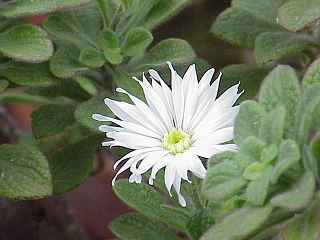
Commidendrum is a genus of trees and shrubs in the sunflower family endemic to the island of Saint Helena in the South Atlantic Ocean. The vernacular name is gumwood or scrubwood.

Goldman's woodrat is a rodent species in the family Cricetidae. It is found only in Mexico throughout the Mexican Plateau, stretching from Southeast Chihuahua to South San Luis Potosi and North Queretaro. The plateau is an average 5,988 ft. above sea level and covers a land area of 232,388 sq. miles.
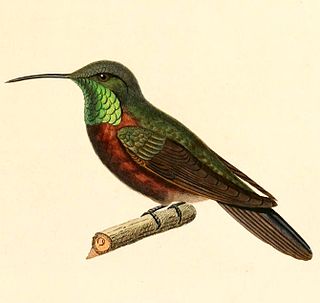
The wedge-tailed hillstar is a species of hummingbird in the family Trochilidae. This sexually dimorphic species is found in scrub and woodland at altitudes of 2,600 to 4,000 metres in the Andes of Bolivia and far north-western border region of Argentina. It is threatened by habitat loss. Uniquely among the hillstars, the flanks of the male are deep chestnut, while the underparts of the female are orange-buff. Like other hillstars it shows a range of adaptations to life at high altitudes, including torpor when roosting. This magnificent and distinctive hummingbird is often seen in gullies, desert habitats, Altiplano, and scattered xerophytic cacti and shrubs. It constructs a substantial and well-lined cup nest that is fixed to a vertical rocky surface. It occurs in heavily populated areas where livestock grazing, planting of non-native species, and deliberate burning damage the native vegetation.
The Bolivian chinchilla rat is a species of chinchilla rat in the family Abrocomidae. It is found only in Manuel María Caballero Province, Bolivia. Its natural habitat is the rocky areas of cloud forests in Bolivia's interior.

Commidendrum spurium, the false gumwood, is a species of flowering plant in the family Asteraceae. It is found only in Saint Helena. Its natural habitats are subtropical or tropical moist lowland forests, rocky areas, and rocky shores. It is threatened by habitat loss.

Leucheria suaveolens, the vanilla daisy, is a species of flowering plant in the family Asteraceae. It is endemic to Falkland Islands. Its natural habitats are temperate shrubland, rocky areas, and rocky shores. It is threatened by habitat loss.
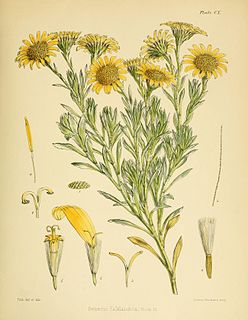
Senecio littoralis, the woolly ragwort, is a species of flowering plant in the aster family. It is endemic to the Falkland Islands. Its natural habitats are temperate shrubland, rocky areas, and rocky shores. This species is threatened by habitat loss.
Draba obovata is a species of plant in the family Brassicaceae. It is endemic to Ecuador. Its natural habitats are subtropical or tropical high-altitude grassland and rocky areas. It is an IUCN Red List Near threatened species, threatened by habitat loss.
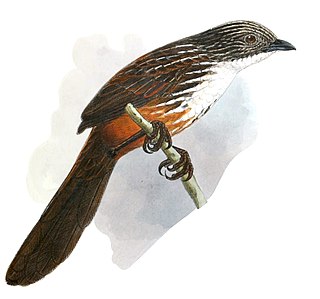
The white-throated grasswren is a species of bird in the family Maluridae. It is endemic to Australia.

The East African epauletted fruit bat is a species of megabat in the family Pteropodidae. It is found in Ethiopia, Kenya, Somalia, Tanzania, and Uganda. Its natural habitats are dry savanna and rocky areas. It is threatened by habitat loss.
Brachyotum rugosum is a species of plant in the family Melastomataceae. It is endemic to Ecuador. Its natural habitats are subtropical or tropical moist montane forests and subtropical or tropical high-altitude shrubland.

Centranthus amazonum is a species of plant in the family Caprifoliaceae. It is endemic to Italy.
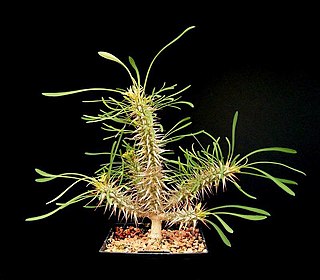
Euphorbia rossii is a species of plant in the family Euphorbiaceae. It is endemic to Madagascar. Its natural habitat is rocky areas. It is threatened by habitat loss. It has reddish-yellow cyathia.

Frankenia portulacifolia, also called Saint Helena tea or tea plant, is a species of salt-tolerant plant in the Frankeniaceae family. It is endemic to the islands of Saint Helena, Ascension and Tristan da Cunha. Its natural habitats are inhospitable, dry and rocky areas and rocky shores, often on weathered volcanic ash. As its total population has been estimated at only around 3,500 individuals, it is currently classified as Critically Endangered by the IUCN.
Nastanthus falklandicus, also called false-plantain, is a species of plant in the Calyceraceae family. It is endemic to Falkland Islands. Its natural habitat is rocky shores.

Philodendron rugosum is a species of plant in the family Araceae.

Polygala sinisica is a species of plant in the family Polygalaceae. It is endemic to Italy.

Wahlenbergia angustifolia, also called small bellflower, is a species of plant in the family Campanulaceae. It is endemic to Saint Helena. Its natural habitat is rocky areas. It is endangered because of habitat loss.

Wahlenbergia linifolia, the large bellflower, is a species of plant in the family Campanulaceae. It is endemic to Saint Helena. Its natural habitat is rocky areas. It is threatened by habitat loss.
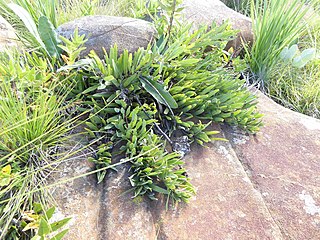
Protea parvula, also known as the dainty sugarbush, or kleinsuikerbos in Afrikaans, is a small flowering shrub belonging to the genus Protea.

















